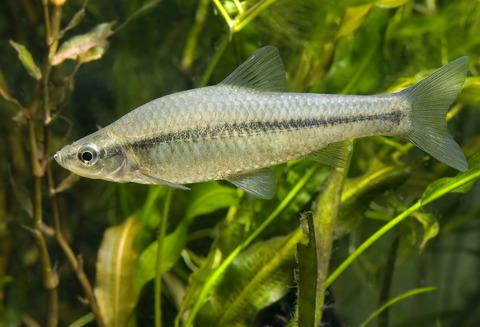当前位置:
X-MOL 学术
›
Ecol. Evol.
›
论文详情
Our official English website, www.x-mol.net, welcomes your
feedback! (Note: you will need to create a separate account there.)
Native drivers of fish life history traits are lost during the invasion process.
Ecology and Evolution ( IF 2.3 ) Pub Date : 2020-08-03 , DOI: 10.1002/ece3.6521 Rodolphe Elie Gozlan,Eva Záhorská,Emira Cherif,Takashi Asaeda,John Robert Britton,Cha-Ho Chang,To Hong,Rafael Miranda,Jiří Musil,Meta Povz,Ali Serhan Tarkan,Elena Tricarico,Teodora Trichkova,Hugo Verreycken,Andrej Weiperth,Andrej Witkowski,Lluis Zamora,Irene Zweimueller,Yahui Zhao,Hamid Reza Esmaeili,Marine Combe
Ecology and Evolution ( IF 2.3 ) Pub Date : 2020-08-03 , DOI: 10.1002/ece3.6521 Rodolphe Elie Gozlan,Eva Záhorská,Emira Cherif,Takashi Asaeda,John Robert Britton,Cha-Ho Chang,To Hong,Rafael Miranda,Jiří Musil,Meta Povz,Ali Serhan Tarkan,Elena Tricarico,Teodora Trichkova,Hugo Verreycken,Andrej Weiperth,Andrej Witkowski,Lluis Zamora,Irene Zweimueller,Yahui Zhao,Hamid Reza Esmaeili,Marine Combe

|
Rapid adaptation to global change can counter vulnerability of species to population declines and extinction. Theoretically, under such circumstances both genetic variation and phenotypic plasticity can maintain population fitness, but empirical support for this is currently limited. Here, we aim to characterize the role of environmental and genetic diversity, and their prior evolutionary history (via haplogroup profiles) in shaping patterns of life history traits during biological invasion. Data were derived from both genetic and life history traits including a morphological analysis of 29 native and invasive populations of topmouth gudgeon Pseudorasbora parva coupled with climatic variables from each location. General additive models were constructed to explain distribution of somatic growth rate (SGR) data across native and invasive ranges, with model selection performed using Akaike's information criteria. Genetic and environmental drivers that structured the life history of populations in their native range were less influential in their invasive populations. For some vertebrates at least, fitness‐related trait shifts do not seem to be dependent on the level of genetic diversity or haplogroup makeup of the initial introduced propagule, nor of the availability of local environmental conditions being similar to those experienced in their native range. As long as local conditions are not beyond the species physiological threshold, its local establishment and invasive potential are likely to be determined by local drivers, such as density‐dependent effects linked to resource availability or to local biotic resistance.
中文翻译:

鱼类生活史特征的本地驱动因素在入侵过程中丢失。
快速适应全球变化可以应对物种数量减少和灭绝的脆弱性。理论上,在这种情况下,遗传变异和表型可塑性都可以维持种群的适应性,但目前对此的实证支持有限。在这里,我们的目标是描述环境和遗传多样性的作用,以及它们先前的进化史(通过单倍群概况)在生物入侵期间塑造生活史特征模式的过程中。数据来源于遗传和生活史特征,包括对 29 个本地和入侵顶嘴鱼Pseudorasbora parva种群的形态学分析以及每个地点的气候变量。构建通用加性模型来解释体细胞生长率 (SGR) 数据在本地和入侵范围内的分布,并使用 Akaike 信息标准进行模型选择。构成其本土种群生活史的遗传和环境驱动因素对其入侵种群的影响较小。至少对于一些脊椎动物来说,与适应度相关的性状转变似乎并不依赖于最初引入的繁殖体的遗传多样性水平或单倍群构成,也不依赖于与本地范围内经历的环境条件相似的当地环境条件的可用性。只要当地条件不超出物种的生理阈值,其在当地的建立和入侵潜力就可能由当地驱动因素决定,例如与资源可用性或当地生物抗性相关的密度依赖性效应。
更新日期:2020-08-28
中文翻译:

鱼类生活史特征的本地驱动因素在入侵过程中丢失。
快速适应全球变化可以应对物种数量减少和灭绝的脆弱性。理论上,在这种情况下,遗传变异和表型可塑性都可以维持种群的适应性,但目前对此的实证支持有限。在这里,我们的目标是描述环境和遗传多样性的作用,以及它们先前的进化史(通过单倍群概况)在生物入侵期间塑造生活史特征模式的过程中。数据来源于遗传和生活史特征,包括对 29 个本地和入侵顶嘴鱼Pseudorasbora parva种群的形态学分析以及每个地点的气候变量。构建通用加性模型来解释体细胞生长率 (SGR) 数据在本地和入侵范围内的分布,并使用 Akaike 信息标准进行模型选择。构成其本土种群生活史的遗传和环境驱动因素对其入侵种群的影响较小。至少对于一些脊椎动物来说,与适应度相关的性状转变似乎并不依赖于最初引入的繁殖体的遗传多样性水平或单倍群构成,也不依赖于与本地范围内经历的环境条件相似的当地环境条件的可用性。只要当地条件不超出物种的生理阈值,其在当地的建立和入侵潜力就可能由当地驱动因素决定,例如与资源可用性或当地生物抗性相关的密度依赖性效应。











































 京公网安备 11010802027423号
京公网安备 11010802027423号